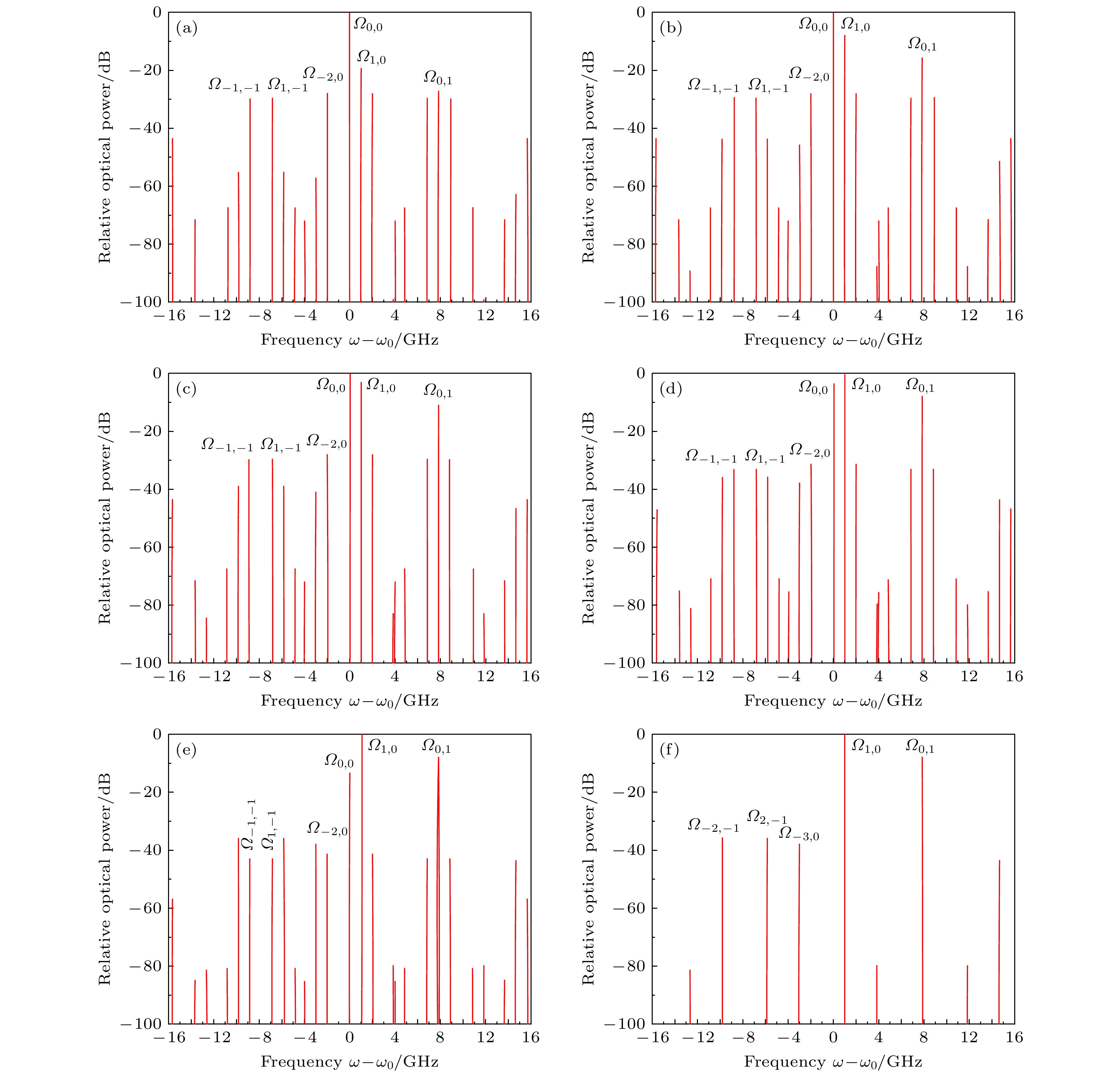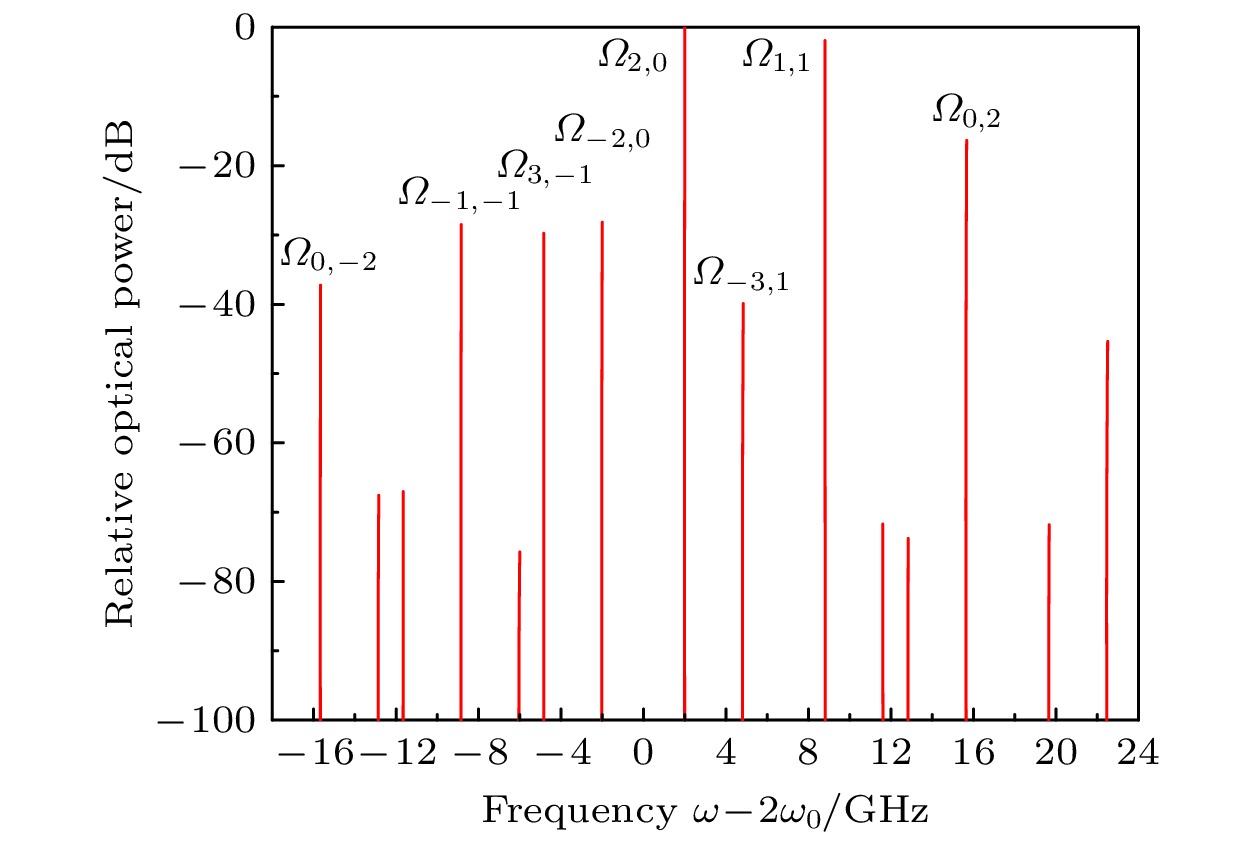-
Using the electro-optical modulation method to generate Raman beams for cold atom interference is one of the better methods for constructing a more compact and robust laser system. But this way will generate some residual sidebands resulting in the additional interference phase shift, which can affect the measurement accuracy of cold atom interferometer. In order to weaken the effect of laser modulation sidebands on the phase shift of cold atom interference, a double-sideband suppressed-carrier modulation laser system for cold atom interference is constructed. Based on the designed laser system, the principle of double-sideband generation and suppression is analyzed in detail, and some residual sidebands are adjusted and controlled. Moreover, some important optical parameters that affect the phase shift of cold atomic interference, such as the initial distance between the Raman retro-reflection mirror and the atomic cloud, the interrogation time between two adjacent Raman pulses, the laser modulation depth and the initial velocity of the atomic cloud, are discussed and optimized. By optimizing these relevant parameters, the influence of residual modulation sidebands on the phase shift of cold atomic interference is weakened drastically. The research results indicate, making use of the method of double-sideband suppression, the phase shift of cold atomic interference can be optimized to 0.7 mrad when the initial distance between the Raman retro-reflection mirror and the atomic cloud is 105 mm, and the interrogation time between two adjacent Raman pulses is 82 ms. More importantly, this work can provide a method for weakening the influence of Raman sideband effect on the phase shift of cold atom interferometer, and the corresponding laser system can be applied to other inertial sensors such as atomic gravimeter or atomic gravity gradiometer.
-
Keywords:
- atomic interference /
- sideband suppression /
- IQ modulation /
- phase shift
[1] Freier C, Hauth M, Schkolnik V, Leykauf B, Schilling M, Wziontek H, Scherneck H G, Müller J, Peters A 2016 J. Phys. Conf. Ser. 723 012050
 Google Scholar
Google Scholar
[2] Hu Q Q, Freier C, Leykauf B, Schkolnik V, Yang J, Krutzik M, Peters A 2017 Phys. Rev. A 96 033414
 Google Scholar
Google Scholar
[3] Wang Y P, Zhong J Q, Song H W, Zhu L, Li Y M, Chen X, Li R, Wang J, Zhan M S 2017 Phys. Rev. A 95 053612
 Google Scholar
Google Scholar
[4] Sorrentino F, Bodart Q, Cacciapuoti L, Lien Y H, Prevedelli M, Rosi G, Salvi L, Tino G M 2014 Phys. Rev. A 89 023607
 Google Scholar
Google Scholar
[5] Dutta I, Savoie D, Fang B, Venon B, Garrido Alzar C L, Geiger R, Landragin A 2016 Phys. Rev. Lett. 116 183003
 Google Scholar
Google Scholar
[6] Kasevich M, Chu S 1991 Phys. Rev. Lett. 67 181
 Google Scholar
Google Scholar
[7] Le Gouët J, Kim J, Bourassin-Bouchet C, Lours M, Landragin A, Pereira Dos Santos F 2009 Opt. Commun. 282 977
 Google Scholar
Google Scholar
[8] Bouyer P, Gustavson T L, Haritos K G, Kasevich M A 1996 Opt. Lett. 21 1502
 Google Scholar
Google Scholar
[9] Kasevich M, Weiss D S, Riis E, Moler K, Kasapi S, Chu S 1991 Phys. Rev. Lett. 66 2297
 Google Scholar
Google Scholar
[10] Peters A, Chung K Y, Chu S 2001 Metrologia 38 25
 Google Scholar
Google Scholar
[11] Zhang X W, Zhong J Q, Tang B, Chen X, Zhu L, Huang P W, Wang J, Zhan M S 2018 Appl. Opt. 57 6545
 Google Scholar
Google Scholar
[12] Carraz O, Lienhart F, Charrière R, Cadoret M, Zahzam N, Bidel Y, Bresson A 2009 Appl. Phys. B 97 405
 Google Scholar
Google Scholar
[13] Zhu L X, Lien Y H, Hinton A, Niggebaum A, Rammeloo C, Bongs K, Holynski M 2018 Opt. Express 26 6542
 Google Scholar
Google Scholar
[14] Rammeloo C, Zhu L X, Lien Y H, Bongs K, Holynski M 2020 J. Opt. Soc. Am. B 37 1485
 Google Scholar
Google Scholar
[15] Carraz O, Charrière R, Cadoret M, Zahzam N, Bidel Y, Bresson A 2012 Phys. Rev. A 86 033605
 Google Scholar
Google Scholar
[16] 吴彬, 程冰, 付志杰, 朱栋, 邬黎明, 王凯楠, 王河林, 王兆英, 王肖隆, 林强 2019 68 194205
 Google Scholar
Google Scholar
Wu B, Cheng B, Fu Z J, Zhu D, Wu L M, Wang K N, Wang H L, Wang Z Y, Wang X L, Lin Q 2019 Acta Phys. Sin. 68 194205
 Google Scholar
Google Scholar
[17] Li W, Pan X, Song N F, Xu X B, Lu X X 2017 Appl. Phys. B 123 54
 Google Scholar
Google Scholar
[18] Wang Q, Qi X H, Liu S Y, Yu J C, Chen X Z 2015 Opt. Express 23 2982
 Google Scholar
Google Scholar
[19] Shimotsu S, Oikawa S, Saitou T, Mitsugi N, Kubodera K, Kawanishi T, Izutsu M 2001 IEEE Photon. Technol. Lett. 13 364
 Google Scholar
Google Scholar
[20] 王侠, 韦慕野, 邓东锋, 何锋, 欧阳竑, 余志强, 伍颖, 李文甫, 杨庆锐, 李鹏伟 2021 光电技术应用 36 47
 Google Scholar
Google Scholar
Wang X, Wei M Y, Deng D F, He F, Ouyang H, Yu Z Q, Wu Y, Li W F, Yang Q R, Li P W 2021 Ele. Optic Technol. Appl. 36 47
 Google Scholar
Google Scholar
[21] Vetsch E, Reitz D, Sague G, Schmidt R, Dawkins S T, Rauschenbeutel A 2010 Phys. Rev. Lett. 104 203603
 Google Scholar
Google Scholar
-
图 1 用于冷原子干涉的边带抑制激光系统图 PID, 比例-积分-微分; PD, 光电二极管; PPLN, 周期性极化铌酸锂; PBS, 偏振分光棱镜; EDFA, 掺铒光纤放大器; AOM, 电光调制器
Figure 1. Diagram of a sideband suppressed laser system for cold atom interference: PID, proportion integration differentiation; PD, photodiode; PPLN, periodically poled lithium niobate; PBS, polarization beam splitter; EDFA, erbium doped fiber amplifier; AOM, acousto-optic modulator.
图 4 波长为1560 nm, ΔΦ1 = ΔΦ2 = π时, 不同的ΔΦ3值对激光边带抑制的频谱图 (a) ΔΦ3 = –π/6; (b) ΔΦ3 = –π/3; (c) ΔΦ3 = –π/2; (d) ΔΦ3 = –2π/3; (e) ΔΦ3 = –5π/6; (f) ΔΦ3 = –π
Figure 4. Spectrogram of laser sideband suppression with different ΔΦ3 values when the wavelength is 1560 nm and ΔΦ1 = ΔΦ2 = π: (a) ΔΦ3 = –π/6; (b) ΔΦ3 = –π/3; (c) ΔΦ3 = –π/2; (d) ΔΦ3 = –2π/3; (e) ΔΦ3 = –5π/6; (f) ΔΦ3 = –π.
图 5 波长为1560 nm, ΔΦ3 = –π/2时, 不同的ΔΦ1和ΔΦ2值对激光边带抑制的频谱图 (a) ΔΦ1, 2 = π/6; (b) ΔΦ1, 2 = π/2; (c) ΔΦ1, 2 = 2π/3; (d) ΔΦ1, 2 = 5π/6; (e) ΔΦ1, 2 = 17π/18; (f) ΔΦ1, 2 = π
Figure 5. Spectrogram of laser sideband suppression with different values of ΔΦ1 and ΔΦ2 when the wavelength is 1560 nm and ΔΦ3 = –π/2: (a) ΔΦ1, 2 = π/6; (b) ΔΦ1, 2 = π/2; (c) ΔΦ1, 2 = 2π/3; (d) ΔΦ1, 2 = 5π/6; (e) ΔΦ1, 2 = 17π/18; (f) ΔΦ1, 2 = π.
图 8 不同间隔时间T下, 拉曼反射镜距离与相移的变化关系 (β1 = 0.55, β2 = 0.23) (a)T = 10, 20, 30, 50, 80 ms时, 相移随ZM变化的关系; (b)不同T下, 相移随ZM变化的峰峰值Δφpp
Figure 8. Relationship between Raman retro-reflection mirror distance and phase shift at different time intervals T (β1 = 0.55, β2 = 0.23): (a) Relationship of the phase shift with ZM at T = 10, 20, 30, 50, 80 ms; (b) the peak-to-peak value (Δφpp) of the phase shift with ZM at different T
图 10 不同的拉曼反射镜距离下, 间隔时间T与原子干涉相移的关系(β1 = 0.55, β2 = 0.23) (a) ZM = 112, 117, 122, 127, 133 mm时, 相移随T变化的关系图; (b)不同ZM下, 相移随T变化的峰峰值Δφpp
Figure 10. Interference time T versus atomic interference phase shift for the different Raman mirror distances (β1 = 0.55, β2 = 0.23): (a) Relationship between the phase shift and T when ZM = 112, 117, 122, 127, 133 mm; (b) the peak-to-peak Δφpp of the phase shift with T at different ZM.
图 12 最终边带抑制和相移结果 (a) 波长为1560 nm时, 激光边带的抑制结果; (b) 波长为780 nm时, 激光边带的抑制结果; (c) T = 82 ms时, 相移与原子团到拉曼反射镜距离的关系; (d) ZM = 105 mm时, 相移与拉曼脉冲间隔时间的关系
Figure 12. Final sideband suppression and phase shift results: (a) Suppression result of the laser sideband when the wavelength is 1560 nm; (b) the suppression result of the laser sideband when the wavelength is 780 nm; (c) the phase shift and the distance from the atomic group to the Raman mirror when T = 82 ms; (d) the relationship between phase shift and Raman pulse interval time at ZM = 105 mm.
表 1 频率参数
Table 1. Frequency parameters.
相关频率 Δf/GHz ΔR/GHz δCO/MHz δHF/GHz 频率值 1.5 0.88 133 6.834 表 2 优化参数
Table 2. Optimization parameters.
参数 ΔΦ1 = ΔΦ2 ΔΦ3 ZM/mm T/ms β1 β2 t0/ms υ0/(mm·s–1) 优化数据 π –π/2 105 82 0.62 0.2 15 –15 -
[1] Freier C, Hauth M, Schkolnik V, Leykauf B, Schilling M, Wziontek H, Scherneck H G, Müller J, Peters A 2016 J. Phys. Conf. Ser. 723 012050
 Google Scholar
Google Scholar
[2] Hu Q Q, Freier C, Leykauf B, Schkolnik V, Yang J, Krutzik M, Peters A 2017 Phys. Rev. A 96 033414
 Google Scholar
Google Scholar
[3] Wang Y P, Zhong J Q, Song H W, Zhu L, Li Y M, Chen X, Li R, Wang J, Zhan M S 2017 Phys. Rev. A 95 053612
 Google Scholar
Google Scholar
[4] Sorrentino F, Bodart Q, Cacciapuoti L, Lien Y H, Prevedelli M, Rosi G, Salvi L, Tino G M 2014 Phys. Rev. A 89 023607
 Google Scholar
Google Scholar
[5] Dutta I, Savoie D, Fang B, Venon B, Garrido Alzar C L, Geiger R, Landragin A 2016 Phys. Rev. Lett. 116 183003
 Google Scholar
Google Scholar
[6] Kasevich M, Chu S 1991 Phys. Rev. Lett. 67 181
 Google Scholar
Google Scholar
[7] Le Gouët J, Kim J, Bourassin-Bouchet C, Lours M, Landragin A, Pereira Dos Santos F 2009 Opt. Commun. 282 977
 Google Scholar
Google Scholar
[8] Bouyer P, Gustavson T L, Haritos K G, Kasevich M A 1996 Opt. Lett. 21 1502
 Google Scholar
Google Scholar
[9] Kasevich M, Weiss D S, Riis E, Moler K, Kasapi S, Chu S 1991 Phys. Rev. Lett. 66 2297
 Google Scholar
Google Scholar
[10] Peters A, Chung K Y, Chu S 2001 Metrologia 38 25
 Google Scholar
Google Scholar
[11] Zhang X W, Zhong J Q, Tang B, Chen X, Zhu L, Huang P W, Wang J, Zhan M S 2018 Appl. Opt. 57 6545
 Google Scholar
Google Scholar
[12] Carraz O, Lienhart F, Charrière R, Cadoret M, Zahzam N, Bidel Y, Bresson A 2009 Appl. Phys. B 97 405
 Google Scholar
Google Scholar
[13] Zhu L X, Lien Y H, Hinton A, Niggebaum A, Rammeloo C, Bongs K, Holynski M 2018 Opt. Express 26 6542
 Google Scholar
Google Scholar
[14] Rammeloo C, Zhu L X, Lien Y H, Bongs K, Holynski M 2020 J. Opt. Soc. Am. B 37 1485
 Google Scholar
Google Scholar
[15] Carraz O, Charrière R, Cadoret M, Zahzam N, Bidel Y, Bresson A 2012 Phys. Rev. A 86 033605
 Google Scholar
Google Scholar
[16] 吴彬, 程冰, 付志杰, 朱栋, 邬黎明, 王凯楠, 王河林, 王兆英, 王肖隆, 林强 2019 68 194205
 Google Scholar
Google Scholar
Wu B, Cheng B, Fu Z J, Zhu D, Wu L M, Wang K N, Wang H L, Wang Z Y, Wang X L, Lin Q 2019 Acta Phys. Sin. 68 194205
 Google Scholar
Google Scholar
[17] Li W, Pan X, Song N F, Xu X B, Lu X X 2017 Appl. Phys. B 123 54
 Google Scholar
Google Scholar
[18] Wang Q, Qi X H, Liu S Y, Yu J C, Chen X Z 2015 Opt. Express 23 2982
 Google Scholar
Google Scholar
[19] Shimotsu S, Oikawa S, Saitou T, Mitsugi N, Kubodera K, Kawanishi T, Izutsu M 2001 IEEE Photon. Technol. Lett. 13 364
 Google Scholar
Google Scholar
[20] 王侠, 韦慕野, 邓东锋, 何锋, 欧阳竑, 余志强, 伍颖, 李文甫, 杨庆锐, 李鹏伟 2021 光电技术应用 36 47
 Google Scholar
Google Scholar
Wang X, Wei M Y, Deng D F, He F, Ouyang H, Yu Z Q, Wu Y, Li W F, Yang Q R, Li P W 2021 Ele. Optic Technol. Appl. 36 47
 Google Scholar
Google Scholar
[21] Vetsch E, Reitz D, Sague G, Schmidt R, Dawkins S T, Rauschenbeutel A 2010 Phys. Rev. Lett. 104 203603
 Google Scholar
Google Scholar
Catalog
Metrics
- Abstract views: 6116
- PDF Downloads: 99
- Cited By: 0















 DownLoad:
DownLoad:











